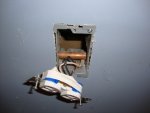dwellselectric
Inactive, Email Never Verified
- Location
- Cape Cod, Massachusetts
It's not bad enough they jumped off a 12/2 kitchen circuit with a 14/2 to add these two outlets. But to use a low voltage ring?!


Sent from my iPhone using Tapatalk


Sent from my iPhone using Tapatalk

